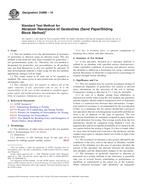Potřebujeme váš souhlas k využití jednotlivých dat, aby se vám mimo jiné mohly ukazovat informace týkající se vašich zájmů. Souhlas udělíte kliknutím na tlačítko „OK“.
ASTM D4886-10
Standard Test Method for Abrasion Resistance of Geotextiles (Sand Paper/Sliding Block Method)
Automaticky přeložený název:
Standardní zkušební metoda pro odolnost proti oděru geotextilií (Sand Paper / Posuvné Block Method)
NORMA vydána dne 1.10.2010
Informace o normě:
Označení normy: ASTM D4886-10
Poznámka: NEPLATNÁ
Datum vydání normy: 1.10.2010
Kód zboží: NS-29027
Počet stran: 3
Přibližná hmotnost: 9 g (0.02 liber)
Země: Americká technická norma
Kategorie: Technické normy ASTM
Kategorie - podobné normy:
Anotace textu normy ASTM D4886-10 :
Keywords:
abrasion resistance, geotextiles, Breaking strength/tenacity, Durability--soil/rock/related materials, Geosynthetics, Loading tests--geosynthetics, Performance--geosynthetics, Polymers (roofing/waterproofing applications), Sand paper/sliding block method, Abrasion resistance--soil/rock/related materials, Wet testing, ICS Number Code 59.080.70 (Geotextiles)
Doplňující informace
| Significance and Use | ||||||||||
|
This test method may be used for acceptance testing of commercial shipments of geotextiles, but caution is advised since information on the precision of the test is lacking. Comparative testing as directed in 5.1.1 may be advisable. In case of a dispute arising from differences in reported test results when using this test method, the purchaser and the supplier should conduct comparative tests to determine if there is a statistical bias between their laboratories. Competent statistical assistance is recommended for the investigation of bias. As a minimum, the two parties should take a group of test specimens that are as homogeneous as possible and that are from a lot of material of the type in question. The test specimens should then be randomly assigned in equal numbers to each laboratory for testing. The average results from the two laboratories should be compared using Student's t-test for unpaired data and an acceptable probability level chosen by the two parties before the testing is begun. If a bias is found, either its cause must be found and corrected or the purchaser and the supplier must agree to interpret future test results in light of the known bias. The resistance of abrasion is also greatly affected by the conditions of the tests, such as the nature of abradant, variable action of the abradant over the area of specimen abraded, the tension of the specimen, the pressure between the specimen and abradant, and the dimensional changes in the specimens. The resistance of geotextile materials to abrasion as measured on a testing machine in the laboratory is generally only one of several factors contributing to performance or durability as experienced in the actual use of the material. While “abrasion resistance” and“ durability” are frequently related, the relationship varies with different end uses, and different factors may be necessary in any calculation of predicted durability from specific abrasion data. Laboratory tests may be reliable as an indication of relative end-use performance in cases where the difference in abrasion resistance of various materials is large, but they should not be relied upon for prediction of actual in-situation life in specific end uses unless there are data showing the specific relationship between laboratory abrasion tests and actual in-situation life in the intended end-use. These general observations apply to all types of fabrics, including woven, nonwoven, and knit fabrics. If there is a disagreement arising from differences in values reported by the purchaser and the seller when using this test method for acceptance testing, the statistical bias, if any, between the laboratory of the purchaser and the laboratory of the seller should be determined with each comparison being based on testing specimens randomly drawn from one sampling unit of material of the type being evaluated. |
||||||||||
| 1. Scope | ||||||||||
|
1.1 This test method covers the determination of resistance of geotextiles to abrasion using an abrasion tester. This test method at this point has only been evaluated for geotextilesnot geomembranes, grids, etc. Therefore, the test method is designated for geotextiles, not geosynthetics, as all products may not lend themselves to this test method for abrasion. If later developments indicate a wider scope for this test method, appropriate changes will be made. 1.2 The values stated in SI units are to be regarded as standard. The values given in inch-pound units are provided as information only. 1.3 This standard does not purport to address all of the safety concerns, if any, associated with its use. It is the responsibility of the user of this standard to establish appropriate safety and health practices and determine the applicability of regulatory limitations prior to use. |
||||||||||
| 2. Referenced Documents | ||||||||||
|




 Cookies
Cookies
